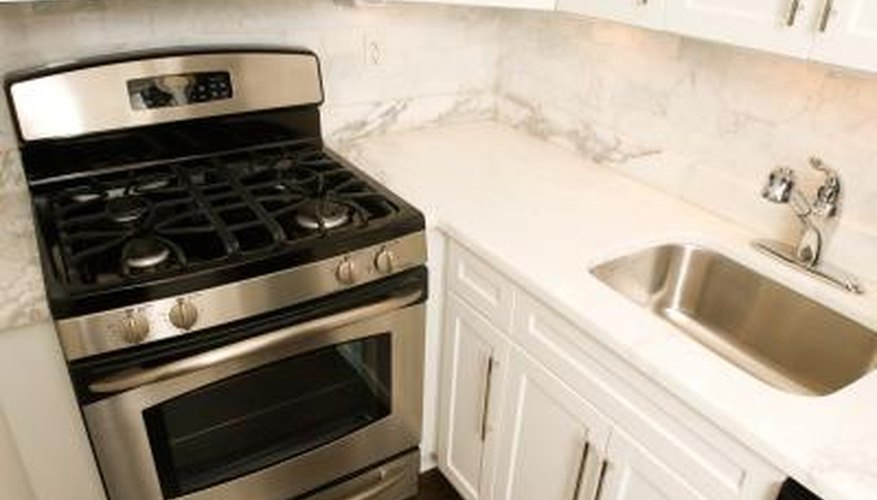If the side wall adjoining a row of wooden cabinets is not plumb, the result may be a gap that forms between the wall and the vertical edge of the cabinets.
If the gap is large, especially in an old building, the visual effect can distract from the natural beauty of well-made wooden cabinets. Dealing with this problem is a challenge, but one that an experienced woodworker can handle.
Check the side wall where the cabinets will be placed to see that it is plumb, using a 4-foot level. Also check the juncture with the ceiling to see that it is square, using a framing square. Do this before the cabinets are built, because if one or both of the walls are not plumb the solution is to install a 6-inch-wide spacer between the cabinet and wall to take up the difference. If this spacer is needed on both sides of a row of cabinets that will be located between two side walls, the row of cabinets will need to be a foot shorter than the actual opening. If there is only one side wall, this difference may not be as important, but you should still check the wall first to see if you will need a spacer.
- If the side wall adjoining a row of wooden cabinets is not plumb, the result may be a gap that forms between the wall and the vertical edge of the cabinets.
- Check the side wall where the cabinets will be placed to see that it is plumb, using a 4-foot level.
Locate the studs on the side wall with a magnetic stud finder. After the stud is located, drive a nail to make sure there really is a stud in the spot that the stud finder indicated. Once the stud location is confirmed draw a line along the centre of the stud to mark its location.
Choose plywood for the spacers that will be cut to fit on either side of the row of cabinets to correct the gap in the wall. It is best to choose a plywood with a veneer that matches the cabinets, but you can also buy the veneer separately and cut and glue it to the piece of plywood. Plywood of 3/4-inch thickness is a good choice for the thickness of the spacers.
Measure the depth of the cabinets. This measurement should include the furring strips that are behind the cabinet, if any are present. Measure the thickness of the front face of the cabinets. This will be the thickness of one board, probably about 3/4 to 1 inch.
- Locate the studs on the side wall with a magnetic stud finder.
- This measurement should include the furring strips that are behind the cabinet, if any are present.
Calculate the length of the 2-by-4s that you will nail to the side wall. To do this, subtract the thickness of the front piece and the thickness of the plywood spacer from the overall depth of the cabinet. For example, if your cabinets are 24 inches deep and the plywood, front piece and furring strip are all 3/4 inch thick, then according to the formula the 2-by-4s will be cut at 23 1/4 inches.
Install the cabinets, leaving an extra 6 inches wherever there is an uneven side wall.
Cut three 2-by-4s to a length of x inches, where x is the length you calculated in Step 5. Nail one to the top of the wall, one at the halfway point and one in a level position x inches down from the top of the cabinets.
Cut a 3/4-inch furring strip to a length of x inches and place it vertically on the side of the cabinets. Leave a space of 7/8 inch between the front piece of the cabinet and this furring strip. Attach the furring strip to the side of the cabinet with glue and 1-inch wood screws.
- Calculate the length of the 2-by-4s that you will nail to the side wall.
- Cut a 3/4-inch furring strip to a length of x inches and place it vertically on the side of the cabinets.
Cut the plywood spacer and nail it into place using #6 finishing nails or screw it into place with 1 1/4-inch wood screws. Measure the spacer carefully because it will vary in width and possibly in height as well. There will be two different width measurements to account for the angle in the wall.
Cut a 20-inch furring strip and run it along the outside of the cabinet, 3/4 inch above the bottom edge of the cabinet. Attach this furring strip with 1-inch wood screws to the side of the cabinet.
- Cut the plywood spacer and nail it into place using #6 finishing nails or screw it into place with 1 1/4-inch wood screws.
- Cut a 20-inch furring strip and run it along the outside of the cabinet, 3/4 inch above the bottom edge of the cabinet.
Measure and cut a piece of plywood to fit behind the spacer and form the bottom surface of the space between the cabinets and the side wall.
Install this bottom spacer with 1-inch wood screws. Be sure to drill a pilot hole first.
TIP
If there is a soffit planned above the cabinets, you need to build and install the soffit first.
WARNING
It is a good idea to check the side wall or walls for squareness before cabinets are ordered or built.
